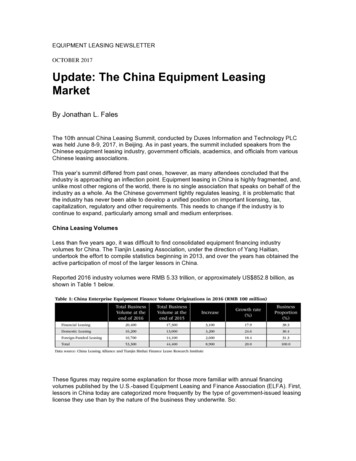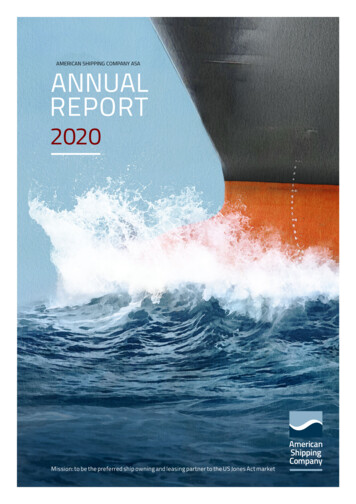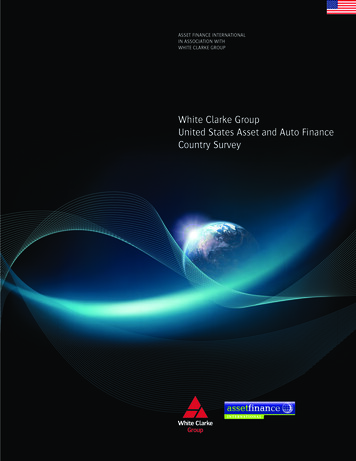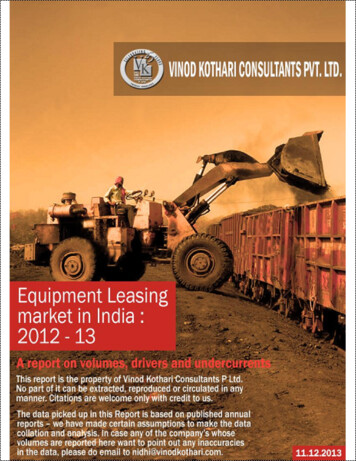
Transcription
EQUIPMENT LEASING NEWSLETTEROCTOBER 2017Update: The China Equipment LeasingMarketBy Jonathan L. FalesThe 10th annual China Leasing Summit, conducted by Duxes Information and Technology PLCwas held June 8-9, 2017, in Beijing. As in past years, the summit included speakers from theChinese equipment leasing industry, government officials, academics, and officials from variousChinese leasing associations.This year’s summit differed from past ones, however, as many attendees concluded that theindustry is approaching an inflection point. Equipment leasing in China is highly fragmented, and,unlike most other regions of the world, there is no single association that speaks on behalf of theindustry as a whole. As the Chinese government tightly regulates leasing, it is problematic thatthe industry has never been able to develop a unified position on important licensing, tax,capitalization, regulatory and other requirements. This needs to change if the industry is tocontinue to expand, particularly among small and medium enterprises.China Leasing VolumesLess than five years ago, it was difficult to find consolidated equipment financing industryvolumes for China. The Tianjin Leasing Association, under the direction of Yang Haitian,undertook the effort to compile statistics beginning in 2013, and over the years has obtained theactive participation of most of the larger lessors in China.Reported 2016 industry volumes were RMB 5.33 trillion, or approximately US 852.8 billion, asshown in Table 1 below.These figures may require some explanation for those more familiar with annual financingvolumes published by the U.S.-based Equipment Leasing and Finance Association (ELFA). First,lessors in China today are categorized more frequently by the type of government-issued leasinglicense they use than by the nature of the business they underwrite. So:
Financial Leasing companies typically are large, Chinese bank-owned lessors that writelarge-ticket transactions, such as aircraft, shipping, and infrastructure-related financingstructures. These lessors are licensed by the China Bank Regulatory Commission(CBRC).Domestic Leasing companies refers to lessors that usually are specially licensed withingovernment-decreed Free Trade Zones, such as those in Shenzhen (established in 1996to promote technology and other industries) and Tianjin (established in 2015, primarily tofacilitate growth of the transportation industry).Foreign-Funded Leasing companies cover a wide range of lessors, most of which arelicensed by the Ministry of Commerce (MOFCOM). The majority of international captivelessors, many international bank lessors, and nearly all small lessors operate underlicenses issued by MOFCOM.Second, the leasing volumes include a large number of sale-leasebacks, particularly amongsmaller lessors. Thousands of small lessors were established over the last five years for the solepurpose of providing sale-leaseback financing to small- and mid-sized companies unable toobtain traditional bank financing. While it is difficult to do a true apples-to-apples comparison withthe U.S. market, it is safe to assume that a significant percentage — some estimates are 90% orhigher — actually are sale-leasebacks. Still, China is home to a sizable volume of equipmentfinancing that is easily in the high tens to over one hundred billion dollars annually.Market SegmentationJiang Zhongquin, a semi-retired veteran of the China leasing industry and an importantspokesperson for issues concerning it, has been a regular speaker at past China LeasingSummits. Jiang spearheaded the successful, multi-year effort to eliminate a provision in the taxcode that penalized underwriters of operating leases in China, and operating lease volumes haveincreased substantially since.At this year’s summit, Jiang observed that China is unlike other developed countries in the way itsleasing industry has developed. Today, most countries either have no licensing requirements or,at most, a single entity that can issue leasing licenses. China has multiple issuing entities —CBRC, the Free Trade Zones, MOFCOM — each with different regulations regardingcapitalization, reporting, tax incentives, and financing products that can be offered. It is notsurprising that a China-wide leasing association has not emerged yet to speak for such diverseinterests.Table 2 below contains the number of registered Chinese lessors, by license type, as of June2017.
Parenthetically, it should be noted that as an illustration of how it is still “early days” in measuringChina’s equipment financing industry, an uncited MOFCOM estimate of leasing companies at theend of 2016 is 6,158, some 978 fewer companies than the 7,136 estimate presented here.Jiang observed that China’s leasing industry has grown steadily over the years, which is reflectiveof China as a whole, but that future growth will be hindered if the various segments fail tocoalesce.One important issue is the availability of credit information. Culturally, it is not unusual for smaller,family-run companies to maintain multiple sets of financial statements, which makes it difficult forlessors to make lending decisions unless the lessor has close (and usually local) knowledge ofthe business. This has severely impeded the availability of credit to smaller companies.In 2006, the CBRC created a credit registry for banks to record and share credit information onborrowers. The registry has proved useful to bank lenders and lessors — but, unfortunately, onlyfor bank lenders and lessors — as use is restricted to institutions licensed by the CBRC. Thus,only 8% of all registered Chinese leasing companies have access to this information. Lack of acommon leasing association representing all lessors means there is no entity working with thegovernment to change this.Another problem is funding. Capitalization requirements range from RMB 100 million for a CBRClicense to RMB 10 million for a MOFCOM license. Non-Chinese-licensed entities are required tosource debt from Chinese banks, but the availability, cost, and amount of funds traditionally hasbeen dictated at the beginning of each quarter by the CBRC. The syndication and securitizationmarkets are therefore difficult to access for small and mid-sized lessors in China. Needless tosay, this makes capital planning and customer support difficult. Lessors have complained aboutthese challenges for years but have been unable to make much progress with the Ministry ofFinance. A single Chinese leasing association would at least give a unified voice to the industry,and to possible solutions.Impact from FintechsPeer-to-peer financial technology companies, or Fintechs, are beginning to make a splash in thefinancing industry in China. So far, their impact has been primarily on bank-related consumerbusiness, but this is growing quickly into the small- and medium-sized business sector.Josh Ye, writing in the South China Morning Post on Aug. 9, 2017, noted the impact Fintech firmsalready have in the banking industry:“Speaking before a crowd of hundreds at the Rise Conference in Hong Kong last month, JingUlrich, vice chairman Asia Pacific at JPMorgan Chase, heaped praise on the two Chinese onlinepayment juggernauts, Alibaba Group’s Alipay and Tencent’s Tenpay.‘JPMorgan, every year, as we speak, processes through our QuickPay 94 million payments,’ hesaid, ‘But Tencent, the Chinese company, over Chinese New Year, in five days processed 46billion payments. Basically that means 800 million payments per hour.‘Visa has a maximum capacity of processing 25,000 payments per second. But Alipay canprocess 50,000 payments, twice as much, per second.’” See Big Banks on Notice That They’reLosing Ground to China’s Fintech Giants. Josh Ye, South China MorningPost,http://bit.ly/2vHFhJr.
Will Fintechs have an impact on the equipment financing industry? Almost certainly, yes. In aNovember 2016 white paper published by DBS Bank of Singapore and EY, the authors state:With high levels of internet and mobile penetration, China is already the world’s largest and mostdeveloped retail e-commerce market, accounting for 47% of global digital retail sales — the resultof a massive domestic retail market in a closed digital economy. Now, these digitally savvyChinese consumers, who have few reservations about sharing personal information, are ready toembrace FinTech offerings, creating opportunities for FinTech firms and incumbents willing totake on digital transformation. These opportunities will come initially from the under-banked orunbanked populations of small and medium enterprises (SMEs) and consumers with unmetneeds.The Rise of FinTech in China: Redefining Financial Services. A collaborative report by DBS andEY, November 2016, https://go.ey.com/2hemdZt.Interestingly, Fintechs should have little trouble entering the Chinese small-ticket equipmentfinancing market: The market is largely unpenetrated by lessors, given the lack of availability of creditinformation.Operating leases, which became common among large-ticket lessors following businesstax reform, are essentially non-existent in China for small-and mid-ticket leasing.Residual-based leases would be harder for Fintechs to transact quickly today, but loansalready are THE core Fintech offering — and dollar-out finance leases are nearlyidentical to loans structurally.The lack of operating leases in China has led to the retarded development of a usedequipment market for most assets. Therefore, the demand for residual-based financingtransactions does not exist among small-ticket lessors today.How will the emergence of Fintechs affect the Chinese equipment leasing market? While it’s tooearly to say with certainty, it’s not hard to imagine the entire small- and mid-ticket leasing marketbeing captured and dominated by Chinese Fintechs within a few years. Existing lessors wouldthen be forced to adopt new technology and processes to compete with Fintechs or move tolarger-ticket/residual-based leasing or go out of business.ConclusionFollowing the 2017 China Leasing Summit, several lessors remained in the auditorium to discussthe state of the industry going forward. Some voiced frustration that progress on tax policy hasmoved so slowly; others lamented the inability for MOFCOM-licensed lessors to obtain the samequality of credit information as CBRC-licensed bank lessors. All agreed that the time has come forthe industry to consolidate its various factions and develop a way to speak with a unified voice tothe Chinese government ministries that oversee leasing, primarily the Ministry of Finance andMinistry of Commerce.An effort to do so has been revived by some Chinese equipment financing industry veterans.These leaders have begun efforts to contact the heads of other Chinese leasing associations forthe purpose of developing an entity that represents the common interests of Chinese lessors.Prior attempts to do so were unsuccessful given the disparate interests of the variousassociations; perhaps this group will succeed.In either case, the face of the Chinese leasing industry is about to change. If a unified leasingassociation is created with the aim of representing all facets of the industry in constructive talkswith government ministries, the pace of equipment financing growth is likely to accelerate.
Otherwise, a disjointed industry may well morph into two groups: big-ticket/CBRC-licensedlessors in one corner; and everyone else — with Fintechs playing a major role — in the other.The 2018 China Leasing Summit should prove to be quite interesting.*****Jonathan L. Fales is a director with The Alta Group, a global consulting firm exclusivelydedicated to the equipment leasing and finance industry. For the past nine years, Mr. Fales hasbeen chair of the China Leasing Summit. The author gratefully acknowledges the assistance ofhis colleague, Adrian Pang, CEO of The Alta Group Asia-Pacific Region, for his contribution inthe preparation of this article.
Update: The China Equipment Leasing Market By Jonathan L. Fales The 10th annual China Leasing Summit, conducted by Duxes Information and Technology PLC was held June 8-9, 2017, in Beijing. As in past years, the summit included speakers from the Chinese equipment leasing industry, government officials, academics, and officials from various









